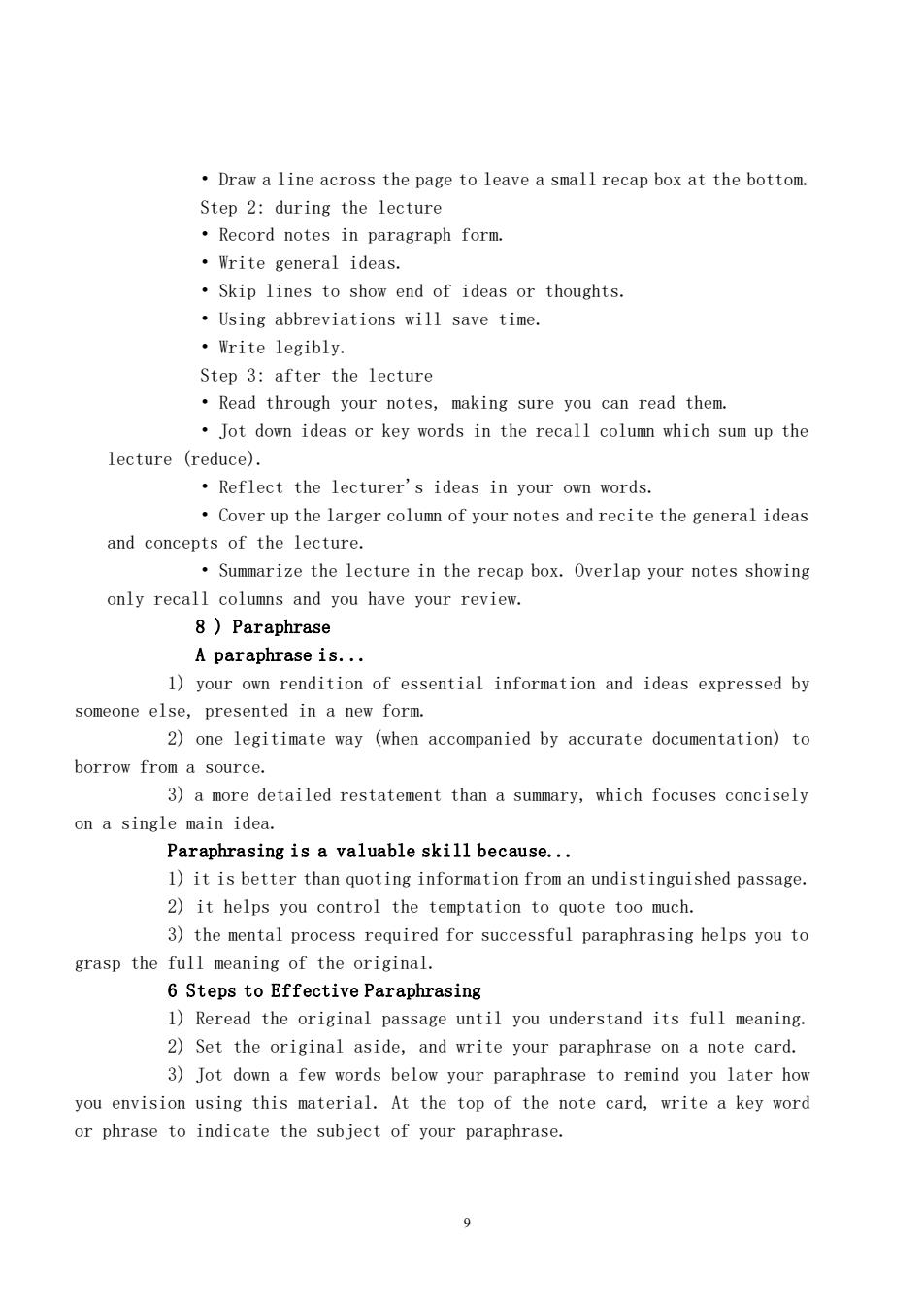正在加载图片...

Draw a line across the page to leave a small recap box at the bottom. Step 2:during the lecture Record notes in paragraph form. ·Write general ideas. Skip lines to show end of ideas or thoughts. Using abbreviations will save time ·Write legibly, Step 3:after the lecture Read through your notes,making sure you can read them. Jot down ideas or key words in the recall column which sum up the lecture (reduce). Reflect the lecturer's ideas in your own words. Cover up the larger column of your notes and recite the general ideas and concepts of the lecture. Summarize the lecture in the recap box.Overlap your notes showing only recall columns and you have your review. 8)Paraphrase A paraphrase is... 1)your own rendition of essential information and ideas expressed by someone else,presented in a new form. 2)one legitimate way (when accompanied by accurate documentation)to borrow from a source. 3)a more detailed restatement than a summary,which focuses concisely on a single main idea. Paraphrasing is a valuable skill because... 1)it is better than quoting information from an undistinguished passage. 2)it helps you control the temptation to quote too much. 3)the mental process required for successful paraphrasing helps you to grasp the full meaning of the original. 6 Steps to Effective Paraphrasing 1)Reread the original passage until you understand its full meaning. 2)Set the original aside,and write your paraphrase on a note card. 3)Jot down a few words below your paraphrase to remind you later how you envision using this material.At the top of the note card,write a key word or phrase to indicate the subject of your paraphrase. 9 9 • Draw a line across the page to leave a small recap box at the bottom. Step 2: during the lecture • Record notes in paragraph form. • Write general ideas. • Skip lines to show end of ideas or thoughts. • Using abbreviations will save time. • Write legibly. Step 3: after the lecture • Read through your notes, making sure you can read them. • Jot down ideas or key words in the recall column which sum up the lecture (reduce). • Reflect the lecturer's ideas in your own words. • Cover up the larger column of your notes and recite the general ideas and concepts of the lecture. • Summarize the lecture in the recap box. Overlap your notes showing only recall columns and you have your review. 8 ) Paraphrase A paraphrase is... 1) your own rendition of essential information and ideas expressed by someone else, presented in a new form. 2) one legitimate way (when accompanied by accurate documentation) to borrow from a source. 3) a more detailed restatement than a summary, which focuses concisely on a single main idea. Paraphrasing is a valuable skill because... 1) it is better than quoting information from an undistinguished passage. 2) it helps you control the temptation to quote too much. 3) the mental process required for successful paraphrasing helps you to grasp the full meaning of the original. 6 Steps to Effective Paraphrasing 1) Reread the original passage until you understand its full meaning. 2) Set the original aside, and write your paraphrase on a note card. 3) Jot down a few words below your paraphrase to remind you later how you envision using this material. At the top of the note card, write a key word or phrase to indicate the subject of your paraphrase